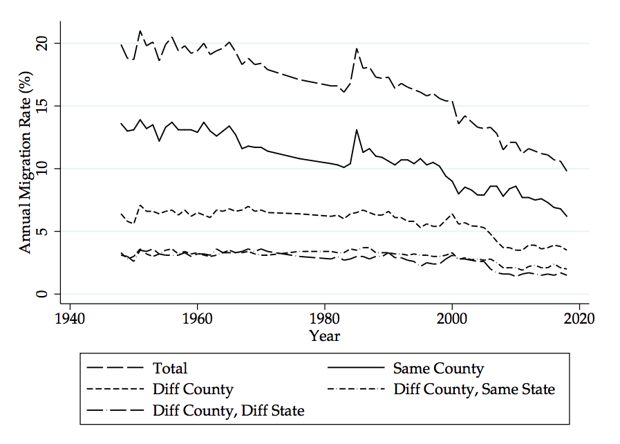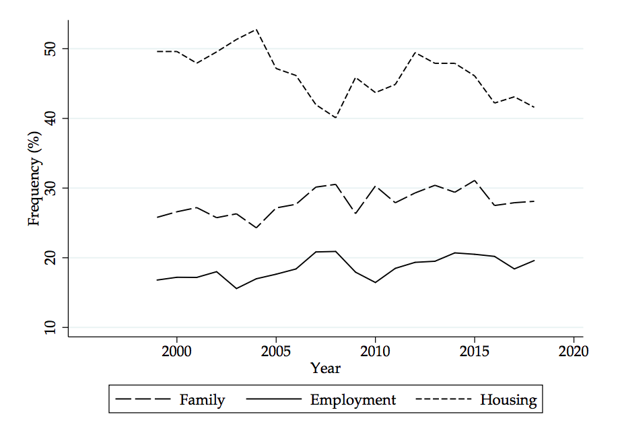A new study identifies powerful psychological factors that connect people to places, and mean more to them than money...
Mobility in the United States has fallen to record lows. In 1985, nearly 20 percent of Americans had changed their residence within the preceding 12 months, but by 2018, fewer than ten percent had. That’s the lowest level since 1948, when the Census Bureau first started tracking mobility.
The decline in Americans’ mobility has been staggering, as the chart below shows. Mobility rates have fallen for nearly every group, across age, gender, income, homeownership status, and marital status.
Declining mobility contributes to a host of economic and social issues: less economic dynamism, lower rates of innovation, and lower productivity. By locking people into place, it exacerbates inequality by limiting the economic opportunities for workers.
Long-run trends in geographic migration in the United States

(Click to enlarge)
Federal Reserve Bank of New York. Data from US Census Bureau Current Population Survey (CPS). Mover rate measures share of U.S. residents age 1 and older whose place of residence in March was different from their place of residence one year earlier.
A wide range of explanations have been offered to account for these substantial declines in mobility. Many consider the culprit to be the economic crisis, which locked people into declining-value homes; others attribute it to the huge differential in the housing prices in expensive cities. Some economists contend that job opportunities have become similar across places, meaning people are less likely to move for work; others see rising student debt as a key factor that has kept young Americans in their parents’ basements.
Now, a new study from the Federal Reserve Bank of New York suggests that other, more emotional and psychological factors may be at work. The study uses data from the bank’s Survey of Consumer Expectations to examine the degree to which people’s attachment to their communities affects their willingness and ability to move. To get at this, they use data from the survey (which covers a monthly panel of 1,300 respondents and is nationally representative) to group Americans into the three mobility classes I identified in my book Who’s Your City: “the mobile” who have the means, education, and capability to move to spaces of opportunity; “the stuck” who lack the resources to relocate; and “the rooted” who have the resources to move, but prefer to stay where they are.
The survey identifies respondents’ most recent move, their probability of moving in the next two years, and other data related to moving including job opportunities and income prospects, housing costs, the distance from current home, costs of moving to various locations, crime rates, taxes, community values and norms, and proximity to family and friends. The researchers use these data to estimate the overall costs—what they call the “willingness to pay” or WTP—for people to move different locations. They then use statistical models to examine the importance of these psychological factors compared to other mostly financial explanations.
A significant reason for the decline in mobility is that many of us are highly attached to our towns. Nearly half of those in the survey (47 percent) identify as rooted. The rooted are disproportionately white, older, married, homeowners, and rural. Their reasons for not moving are more psychological than economic: proximity to family and friends, and their involvement in the local community or church. Related: Amazon Set To Leave Many Of Its Long-Time Vendors
Another 15 percent identify as stuck, lacking the resources or ability to move. The stuck have less formal education, are in worse health, and are less satisfied with their jobs, the survey finds. In addition, they are more likely to live in cities and live relatively close to family members. Their reasons for not moving are mainly economic: the costs of moving, the affordability of housing in other locations, the difficulty of qualifying for a new mortgage, and the perception that there is less opportunity for them elsewhere.
Taken together, the stuck and the rooted make up a huge fraction of the population, more than 60 percent. Indeed, the average chance of moving in the next two years is 25 percent as reported by survey respondents, while the median person reports an even lower 10 percent chance of moving. And, nearly a quarter of respondents say there is zero percent chance they will move the next two years. As the study notes: “The average respondent has much stronger views about reasons not to move than about reasons to move.”
Just 38 percent of respondents say they are mobile with the resources, ability, and inclination to make a move. In fact, 5 percent of respondents say there is a 100 percent chance of their moving. The mobile are most likely to live in cities, though the income and educational background of the mobile and the rooted are similar.
Reasons for moving, 1999-2018

(Click to enlarge)
Federal Reserve Bank of New York. Data from US Census Bureau Current Population Survey (CPS).
It turns out that the personal costs of moving—and leaving family members, loved ones, and friends behind—are quite high. According to the study, the average American perceives not moving as worth a sacrifice of more than 100 percent of income. The psychological cost of leaving family and friends alone equates to 30 percent. As the study reads: “The median person in our sample will forego 30 percent of his or her income in order to stay close to family.”
The worth of not moving is higher for those who own their homes (137 percent of current income for owners vs. 62 percent for renters), for those who did not graduate from college (137 percent for non-graduates vs. 97 percent for graduates), and for older residents (270 percent for people over 50 years of age vs. 57 percent for people under 50). Ultimately, the study estimates that the mobile perceives a cost of 33 percent of income to move. And this “willingness to pay” rises far higher for the rooted; as the authors put it: “Our finding of strong preferences for family and local cultural norms suggest that these factors may be acting as migration multipliers.”
The study uses the example of a move of 1,000 miles, to a community where housing costs 20 percent more and with a tax rate that is 5 percent higher, with less agreeable values and norms, and leaving behind family and friends. For the median person, that move would be perceived as worth a sacrifice of 187 percent of annual income. For the median member of the mobile, it adds up to just under 100 percent of income. But for the median member of the rooted, the cost would be even higher—“infinite” is how the study puts it.
America is not just split between expensive cities of opportunity and “the rest.” Moving is about more than finding a job or a more affordable home; it’s a highly personal decision with deep psychological costs. Nearly half of Americans are rooted in the communities, willing to sacrifice substantial income and opportunity to be around people and places they love. It is of no use to tell them to abandon their community ties when the costs to their well-being are so high. This is a critical, and all too often overlooked, dimension of our geographic divide.
By Zerohedge.com
More Top Reads From Safehaven.com:

















